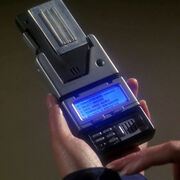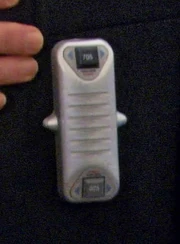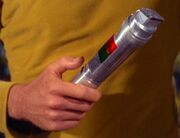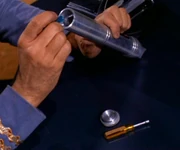m (corrected error in date of ENT: "Demons", corrected grammar) |
m (+ link) Tag: sourceedit |
||
| (28 intermediate revisions by 20 users not shown) | |||
| Line 1: | Line 1: | ||
| − | [[File: |
+ | [[File:Starfleet universal translator, 2150s.jpg|thumb|A [[Starfleet]]-issued universal translator from the [[2150s]]]] |
| + | [[File:Universal translator, 2155.jpg|thumb|A universal translator in 2155]] |
||
| ⚫ | |||
| + | [[File:Universal translator, 2267.jpg|thumb|23rd century shuttlecraft universal translator]] |
||
| ⚫ | |||
| − | On [[Earth]], the universal translator was invented shortly before [[2151]], and was still experimental at the time of the launch of the |
+ | On [[Earth]], the universal translator was invented shortly before [[2151]], and was still experimental at the time of the launch of the {{EnterpriseNX}}. ({{ENT|Broken Bow}}) Despite its being able to translate alien languages in relatively short order, due to the UT's experimental nature, the use of a skilled linguist – in ''Enterprise''{{'}}s case, [[Hoshi Sato]] – was still required, notably in situations where reading alien languages on the control panels, hatches, and displays were involved. ({{ENT|Sleeping Dogs|Vox Sola}}) A new language could quickly be translated in person-to-person encounters by having one speak his or her language until the universal translator gathered enough data to build a [[translation matrix]]. Sato also created the [[linguacode]] translation matrix in order to anticipate and speed up the translation of new and unknown languages. ({{ENT|In a Mirror, Darkly}}) |
The actual universal translator, which was used for deciphering unknown languages on the fly, was a handheld device with a keypad and display to which a [[communicator]] could attach at the top. ({{ENT|Precious Cargo}}) The communicator was also apparently able to translate preprogrammed languages without having the full universal translator attached. ({{ENT|Civilization}}) Additionally, small translators, able to be clipped onto clothing, were available in [[2155]] to function as a standalone version of what was usually built into communicators of the era. ({{ENT|Demons}}) |
The actual universal translator, which was used for deciphering unknown languages on the fly, was a handheld device with a keypad and display to which a [[communicator]] could attach at the top. ({{ENT|Precious Cargo}}) The communicator was also apparently able to translate preprogrammed languages without having the full universal translator attached. ({{ENT|Civilization}}) Additionally, small translators, able to be clipped onto clothing, were available in [[2155]] to function as a standalone version of what was usually built into communicators of the era. ({{ENT|Demons}}) |
||
| ⚫ | |||
| ⚫ | |||
| − | |||
| ⚫ | |||
[[File:Universal translator being modified.jpg|thumb|Spock modifying a universal translator]] |
[[File:Universal translator being modified.jpg|thumb|Spock modifying a universal translator]] |
||
| − | In [[2267]], [[Captain]] [[James T. Kirk|Kirk]] and [[Commander]] [[Spock]] of the {{USS|Enterprise|NCC-1701}} modified one to communicate with the alien known as the [[Companion]] in the [[Gamma Canaris region]]. Responding to [[Zefram Cochrane]]'s question about the theory of operation, Kirk explained that there |
+ | In [[2267]], [[Captain]] [[James T. Kirk|Kirk]] and [[Commander]] [[Spock]] of the {{USS|Enterprise|NCC-1701}} modified one to communicate with the alien known as the [[Companion]] in the [[Gamma Canaris region]]. Responding to [[Zefram Cochrane]]'s question about the theory of operation, Kirk explained that there were certain universal ideas and concepts common to all intelligent life, and that the translator compared the frequencies of [[brain]]wave patterns, selected those ideas it recognized, and provided the necessary grammar. Kirk further explained that the device spoke with a voice, or the approximation of one, that corresponded to the identity concepts it recognized. The Companion was revealed to be female because the universal translator detected this facet of its identity from its brainwave patterns, and assigned it a female voice. ({{TOS|Metamorphosis}}) |
| + | |||
| ⚫ | |||
The universal translator was able to translate the language of the sentient [[nanite]]s, created by [[Wesley Crusher]] in early [[2366]], into [[binary language]]. ({{TNG|Evolution}}) |
The universal translator was able to translate the language of the sentient [[nanite]]s, created by [[Wesley Crusher]] in early [[2366]], into [[binary language]]. ({{TNG|Evolution}}) |
||
| Line 21: | Line 23: | ||
The universal translator could be detected when it was used to process language in communications. In [[2293]], [[Commander]]s [[Pavel Chekov|Chekov]] and [[Nyota Uhura|Uhura]] were forced to revert to manually translating their speech using a paper dictionary into [[Klingon]] in order to surreptitiously get them past the border. Uhura successfully used very broken Klingon to describe the {{USS|Enterprise|NCC-1701-A|-A}} as a [[freighter]], the ''[[Ursva]]'', headed to [[Rura Penthe]] to deliver supplies. The use of paper dictionaries was explained by Chekov as necessary because the use of universal translator would have been recognized. ({{film|6}}) |
The universal translator could be detected when it was used to process language in communications. In [[2293]], [[Commander]]s [[Pavel Chekov|Chekov]] and [[Nyota Uhura|Uhura]] were forced to revert to manually translating their speech using a paper dictionary into [[Klingon]] in order to surreptitiously get them past the border. Uhura successfully used very broken Klingon to describe the {{USS|Enterprise|NCC-1701-A|-A}} as a [[freighter]], the ''[[Ursva]]'', headed to [[Rura Penthe]] to deliver supplies. The use of paper dictionaries was explained by Chekov as necessary because the use of universal translator would have been recognized. ({{film|6}}) |
||
| − | The universal translator's capabilities were focused on interpreting the brain patterns of [[humanoid]] lifeforms. For entirely non-Human lifeforms, such as the [[cytoplasmic lifeform]] which attached itself to [[B'Elanna Torres]], the universal translator was completely stymied, though with some, such as a [[symbiotic lifeform]] encountered by |
+ | The universal translator's capabilities were focused on interpreting the brain patterns of [[humanoid]] lifeforms. For entirely non-Human lifeforms, such as the [[cytoplasmic lifeform]] which attached itself to [[B'Elanna Torres]], the universal translator was completely stymied, though with some, such as a [[symbiotic lifeform]] encountered by {{EnterpriseNX}} in [[2152]], it could still provide some help. ({{VOY|Nothing Human}}; {{ENT|Vox Sola}}) |
At one time while [[Neelix]] was negotiating with a [[xenon-based lifeform]], the UT went off-line and [[Arturis]] saved him from embarrassment by translating the alien's words. ({{VOY|Hope and Fear}}) |
At one time while [[Neelix]] was negotiating with a [[xenon-based lifeform]], the UT went off-line and [[Arturis]] saved him from embarrassment by translating the alien's words. ({{VOY|Hope and Fear}}) |
||
| − | [[Ferengi]] translators evolved from hand-held devices in the [[22nd century]] into small devices inserted into the ear. ({{ENT|Acquisition}}) These later models were easily disrupted by [[nuclear |
+ | [[Ferengi]] translators evolved from hand-held devices in the [[22nd century]] into small devices inserted into the ear. ({{ENT|Acquisition}}) These later models were easily disrupted by radiation from [[nuclear fission]]. ({{DS9|Little Green Men}}) |
[[Cardassian]] universal translators had to be manually adjusted in order to properly translate the [[Breen]] language. ({{DS9|Strange Bedfellows}}) |
[[Cardassian]] universal translators had to be manually adjusted in order to properly translate the [[Breen]] language. ({{DS9|Strange Bedfellows}}) |
||
| + | [[File:EMHMarkI.jpg|thumb|The Emergency Medical Hologram was equipped with a built-in universal translator]] |
||
| ⚫ | |||
| + | The [[Emergency Medical Holographic program]] contained the universal translator technology built-in to his program. {{USS|Voyager}}'s EMH was able to communicate with [[Noss]] when [[Tuvok]] and [[Tom Paris]]' universal translators were offline. ({{VOY|Gravity}}) |
||
| ⚫ | The universal translator is one of many ''Star Trek'' technologies that exist primarily as conventions to aid storytelling. The UT enables the vast majority of dialog between characters to be written (and delivered) in English, to the convenience of viewers and writers alike. Writers do not have to devise a new language for each new [[alien of the week]] that speaks on-screen, and viewers do not have to watch for subtitles. |
||
| + | |||
| − | |||
| ⚫ | |||
| ⚫ | Another storytelling conceit is that the device makes non-English speakers |
||
| ⚫ | The universal translator is one of many ''[[Star Trek]]'' technologies that exist primarily as conventions to aid storytelling. The UT enables the vast majority of dialog between characters to be written (and delivered) in English, to the convenience of viewers and writers alike. Writers do not have to devise a new language for each new [[alien of the week]] that speaks on-screen, and viewers do not have to watch for subtitles. |
||
| + | |||
| ⚫ | Another storytelling conceit is that the device makes non-English speakers appear as if they're speaking English (i.e. lip movements match English language pronunciation). This "convention" is particularly obvious in episodes like {{DS9|Little Green Men}} as well as {{ENT|Unexpected|Civilization|Acquisition}}, and {{e|Precious Cargo}}, in each of which the universal translator is off-line for periods of time. Were the device real, it would more likely have an effect similar to watching a movie dubbed into another language. |
||
The draft proposal ''[[Star Trek is...]]'' mentions this concept: |
The draft proposal ''[[Star Trek is...]]'' mentions this concept: |
||
:''We establish a "telecommunicator" device early in the series, little more complicated than a small transistor radio carried in a pocket. A simple "two-way scrambler", it appears to be converting all spoken language into English.'' (Roddenberry 11) |
:''We establish a "telecommunicator" device early in the series, little more complicated than a small transistor radio carried in a pocket. A simple "two-way scrambler", it appears to be converting all spoken language into English.'' (Roddenberry 11) |
||
| + | |||
| + | During the writing of {{e|The Corbomite Maneuver}} (the first regular installment of ''Star Trek'', following the pilot episodes {{e|The Cage}} and {{e|Where No Man Has Gone Before}}), the universal translator underwent some further development. [[Jerry Sohl]], the writer of "The Corbomite Maneuver", later explained, "''We were originally going to have [each crew member] carry a language translator, which would fit on the wrist like a beeper, and no matter what area of the universe they were in, the thoughts that the people were thinking would automatically be translated into English as they spoke. We got rid of that idea, and assumed that everybody did speak English.''" (''[[The Star Trek Interview Book]]'', pp. 127-128) |
||
==See also== |
==See also== |
||
| − | *[[Linguacode]] |
+ | * [[Linguacode]] |
| − | *[[Linguistic database]] |
+ | * [[Linguistic database]] |
| − | *[[Recording-translating device]] |
+ | * [[Recording-translating device]] |
| − | *[[Translation algorithm]] |
+ | * [[Translation algorithm]] |
| − | *[[Translation matrix]] |
+ | * [[Translation matrix]] |
| + | ==External link== |
||
| + | * {{mbeta}} |
||
[[de:Universalübersetzer]] |
[[de:Universalübersetzer]] |
||
| + | [[fr:Traducteur universel]] |
||
[[it:Traduttore universale]] |
[[it:Traduttore universale]] |
||
[[ja:宇宙翻訳機]] |
[[ja:宇宙翻訳機]] |
||
Revision as of 12:52, 23 January 2016


A universal translator in 2155

23rd century shuttlecraft universal translator
The universal translator (also referred to as a "UT" or translator circuit) was a device used to decipher and interpret alien languages into the native language of the user. (ENT: "Fight or Flight", "Vanishing Point"; TNG: "Home Soil")
On Earth, the universal translator was invented shortly before 2151, and was still experimental at the time of the launch of the Enterprise NX-01. (ENT: "Broken Bow") Despite its being able to translate alien languages in relatively short order, due to the UT's experimental nature, the use of a skilled linguist – in Enterprise's case, Hoshi Sato – was still required, notably in situations where reading alien languages on the control panels, hatches, and displays were involved. (ENT: "Sleeping Dogs", "Vox Sola") A new language could quickly be translated in person-to-person encounters by having one speak his or her language until the universal translator gathered enough data to build a translation matrix. Sato also created the linguacode translation matrix in order to anticipate and speed up the translation of new and unknown languages. (ENT: "In a Mirror, Darkly")
The actual universal translator, which was used for deciphering unknown languages on the fly, was a handheld device with a keypad and display to which a communicator could attach at the top. (ENT: "Precious Cargo") The communicator was also apparently able to translate preprogrammed languages without having the full universal translator attached. (ENT: "Civilization") Additionally, small translators, able to be clipped onto clothing, were available in 2155 to function as a standalone version of what was usually built into communicators of the era. (ENT: "Demons")
Universal translators were also built into the com systems of most starships, including shuttlecraft. In 2267, the UT from a class F shuttlecraft had a wand-like design. (TOS: "Metamorphosis")

Spock modifying a universal translator
In 2267, Captain Kirk and Commander Spock of the USS Enterprise modified one to communicate with the alien known as the Companion in the Gamma Canaris region. Responding to Zefram Cochrane's question about the theory of operation, Kirk explained that there were certain universal ideas and concepts common to all intelligent life, and that the translator compared the frequencies of brainwave patterns, selected those ideas it recognized, and provided the necessary grammar. Kirk further explained that the device spoke with a voice, or the approximation of one, that corresponded to the identity concepts it recognized. The Companion was revealed to be female because the universal translator detected this facet of its identity from its brainwave patterns, and assigned it a female voice. (TOS: "Metamorphosis")
By the 24th century, universal translators had advanced to the point where a full-fledged UT could be built into the combadges worn by Starfleet personnel. (VOY: "The 37's")
The universal translator was able to translate the language of the sentient nanites, created by Wesley Crusher in early 2366, into binary language. (TNG: "Evolution")
The universal translator failed from time to time. For example, it was capable of translating the literal words of the Tamarians into English, but it was unable to translate the Tamarians metaphorical manner of speaking into easily understandable speech. The translator also missed the nuances of Dominionese grammar, failing to render the "passive voice transitive" into English. (TNG: "Darmok"; DS9: "Statistical Probabilities")
Another language the UT had trouble deciphering was that of the Skrreeans. Several hours were required to record and analyze the language before a proper translation form was created. (DS9: "Sanctuary")
The universal translator could be detected when it was used to process language in communications. In 2293, Commanders Chekov and Uhura were forced to revert to manually translating their speech using a paper dictionary into Klingon in order to surreptitiously get them past the border. Uhura successfully used very broken Klingon to describe the USS Enterprise-A as a freighter, the Ursva, headed to Rura Penthe to deliver supplies. The use of paper dictionaries was explained by Chekov as necessary because the use of universal translator would have been recognized. (Star Trek VI: The Undiscovered Country)
The universal translator's capabilities were focused on interpreting the brain patterns of humanoid lifeforms. For entirely non-Human lifeforms, such as the cytoplasmic lifeform which attached itself to B'Elanna Torres, the universal translator was completely stymied, though with some, such as a symbiotic lifeform encountered by Enterprise NX-01 in 2152, it could still provide some help. (VOY: "Nothing Human"; ENT: "Vox Sola")
At one time while Neelix was negotiating with a xenon-based lifeform, the UT went off-line and Arturis saved him from embarrassment by translating the alien's words. (VOY: "Hope and Fear")
Ferengi translators evolved from hand-held devices in the 22nd century into small devices inserted into the ear. (ENT: "Acquisition") These later models were easily disrupted by radiation from nuclear fission. (DS9: "Little Green Men")
Cardassian universal translators had to be manually adjusted in order to properly translate the Breen language. (DS9: "Strange Bedfellows")
The Emergency Medical Hologram was equipped with a built-in universal translator
The Emergency Medical Holographic program contained the universal translator technology built-in to his program. USS Voyager's EMH was able to communicate with Noss when Tuvok and Tom Paris' universal translators were offline. (VOY: "Gravity")
Background information
The universal translator is one of many Star Trek technologies that exist primarily as conventions to aid storytelling. The UT enables the vast majority of dialog between characters to be written (and delivered) in English, to the convenience of viewers and writers alike. Writers do not have to devise a new language for each new alien of the week that speaks on-screen, and viewers do not have to watch for subtitles.
Another storytelling conceit is that the device makes non-English speakers appear as if they're speaking English (i.e. lip movements match English language pronunciation). This "convention" is particularly obvious in episodes like DS9: "Little Green Men" as well as ENT: "Unexpected", "Civilization", "Acquisition", and "Precious Cargo", in each of which the universal translator is off-line for periods of time. Were the device real, it would more likely have an effect similar to watching a movie dubbed into another language.
The draft proposal Star Trek is... mentions this concept:
- We establish a "telecommunicator" device early in the series, little more complicated than a small transistor radio carried in a pocket. A simple "two-way scrambler", it appears to be converting all spoken language into English. (Roddenberry 11)
During the writing of "The Corbomite Maneuver" (the first regular installment of Star Trek, following the pilot episodes "The Cage" and "Where No Man Has Gone Before"), the universal translator underwent some further development. Jerry Sohl, the writer of "The Corbomite Maneuver", later explained, "We were originally going to have [each crew member] carry a language translator, which would fit on the wrist like a beeper, and no matter what area of the universe they were in, the thoughts that the people were thinking would automatically be translated into English as they spoke. We got rid of that idea, and assumed that everybody did speak English." (The Star Trek Interview Book, pp. 127-128)
See also
- Linguacode
- Linguistic database
- Recording-translating device
- Translation algorithm
- Translation matrix
External link
- Universal translator at Memory Beta, the wiki for licensed Star Trek works
